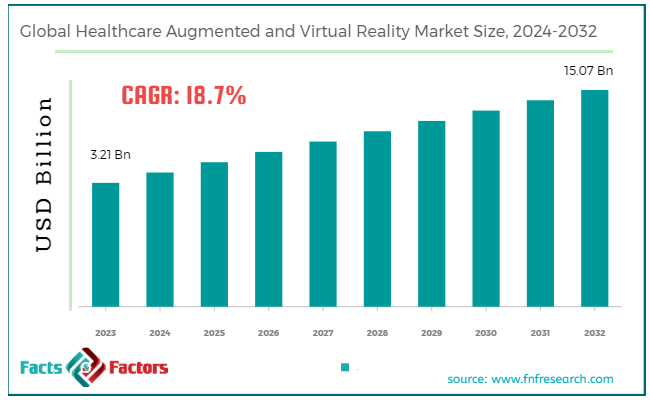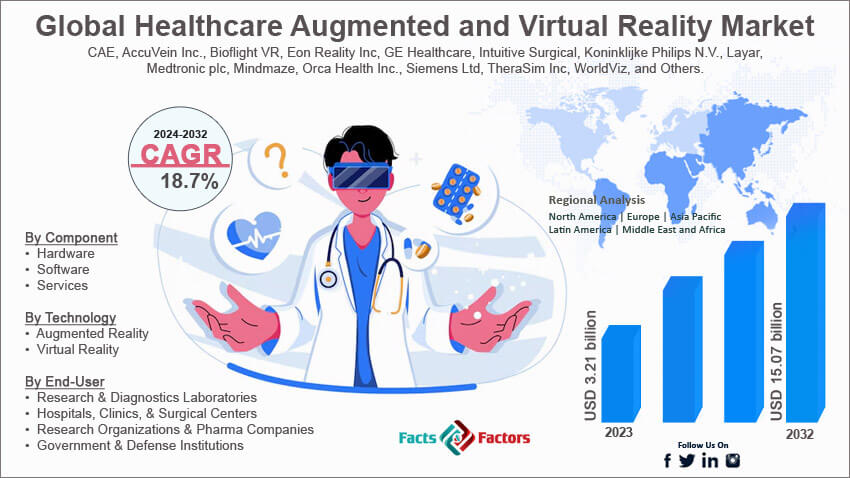Search Market Research Report
Healthcare Augmented and Virtual Reality Market Size, Share Global Analysis Report, 2024 – 2032

Healthcare Augmented and Virtual Reality Market Size, Share, Growth Analysis Report By Component (Hardware, Software, and Services), By Technology (Augmented Reality and Virtual Reality), By End-User (Research & Diagnostics Laboratories, Hospitals, Clinics, & Surgical Centers, Research Organizations & Pharma Companies, Government & Defense Institutions, and Others), and By Region - Global and Regional Industry Insights, Overview, Comprehensive Analysis, Trends, Statistical Research, Market Intelligence, Historical Data and Forecast 2024 – 2032
Industry Insights
[212+ Pages Report] According to Facts & Factors, the global healthcare augmented and virtual reality market size in terms of revenue was valued at around USD 3.21 billion in 2023 and is expected to reach a value of USD 15.07 billion by 2032, growing at a CAGR of roughly 18.7% from 2024 to 2032. The global healthcare augmented and virtual reality market is projected to grow at a significant growth rate due to several driving factors.

 Market Overview
Market Overview
Healthcare augmented reality (AR) and virtual reality (VR) involve the use of advanced technologies to create immersive and interactive environments for medical applications. AR enhances the real-world environment by overlaying digital information, while VR provides a completely virtual environment. These technologies are used for various purposes in healthcare, including medical training, surgical planning, patient treatment, and rehabilitation.
The healthcare AR and VR market is rapidly expanding, driven by technological advancements, increasing adoption of AR and VR in medical training and treatment, and rising investment in healthcare innovation. These technologies are transforming the way healthcare professionals learn, practice, and deliver patient care.
 Key Highlights
Key Highlights
- The healthcare augmented and virtual reality market has registered a CAGR of 18.7% during the forecast period.
- In terms of revenue, the global healthcare augmented and virtual reality market was estimated at roughly USD 3.21 billion in 2023 and is predicted to attain a value of USD 15.07 billion by 2032.
- The growth of the healthcare augmented and virtual reality market is being propelled by technological advancements, increasing adoption in medical training and patient care, and rising investments in healthcare innovation.
- On the basis of component, the hardware segment is growing at a high rate and is projected to dominate the global market.
- Based on the technology, the augmented reality segment is projected to swipe the largest market share.
- By region, North America dominates the market due to advanced healthcare infrastructure, significant investments in healthcare innovation, and the presence of major AR and VR companies.

 Healthcare Augmented and Virtual Reality Market: Key Growth Drivers
Healthcare Augmented and Virtual Reality Market: Key Growth Drivers
- Technological Advancements: Improvements in display technology, processing power, and wearable devices are making AR/VR solutions more affordable, user-friendly, and powerful.
- Rising Demand for Improved Healthcare: The growing demand for minimally invasive procedures, enhanced training for medical professionals, and improved patient experiences fuels the market.
- Increased Investment: Growing recognition of AR/VR's potential is attracting investments from healthcare institutions, technology companies, and venture capitalists.
 Restraints:
Restraints:
- High Initial Costs: The initial investment required for AR/VR hardware and software can be a barrier for some healthcare providers.
- Data Security and Privacy Concerns: Managing patient data privacy and security within AR/VR environments requires robust safeguards.
- Limited Reimbursement Policies: Current healthcare reimbursement policies may not adequately cover AR/VR-based treatments, hindering adoption.
 Opportunities:
Opportunities:
- Focus on Specific Applications: Developing targeted AR/VR solutions for specific procedures, phobias, or rehabilitation programs can unlock new market segments.
- Integration with Artificial Intelligence: Combining AR/VR with AI for real-time data analysis and decision support holds immense potential.
- Expansion into Emerging Markets: Growing healthcare infrastructure and rising disposable incomes in developing economies present exciting opportunities.
 Challenges:
Challenges:
- Standardization and Regulations: Clear regulations and standards for AR/VR use in healthcare are needed to ensure patient safety and data privacy.
- User Acceptance and Adoption: Encouraging healthcare professionals and patients to adopt AR/VR technology requires addressing concerns about user experience and potential side effects.
- Technical Limitations: Battery life, ergonomic design, and potential for motion sickness in VR environments need further refinement.
 Healthcare Augmented and Virtual Reality Market: Segmentation Analysis
Healthcare Augmented and Virtual Reality Market: Segmentation Analysis
The global healthcare augmented and virtual reality market is segmented based on component, technology, end-user, and region.
 By Component Insights
By Component Insights
Based on Component, the global healthcare augmented and virtual reality market is divided into hardware, software, and services.
The hardware segment accounted for 68.6% of the total revenue share in 2023. The hardware segment of the healthcare AR & VR market includes essential devices such as AR and VR headsets, smart glasses, sensors, and cameras. These devices are critical for delivering immersive and interactive experiences in various healthcare applications. AR and VR headsets are central to medical training, surgical simulations, and patient care, while smart glasses overlay digital information onto the real world, aiding in surgeries and diagnostics. Sensors and cameras enhance the interactivity and accuracy of AR & VR applications. The demand for AR & VR hardware in healthcare is driven by technological advancements and the increasing adoption of immersive technologies. Continuous improvements in hardware capabilities, such as higher resolution displays and better motion tracking, support market growth, though high costs and the need for regular upgrades present challenges.
The software segment encompasses various applications, platforms, and systems that enable AR & VR functionalities in healthcare. This segment is projected to grow rapidly during the forecast period. This includes specialized medical software, training applications, and platforms for creating and managing AR & VR content. Medical training software provides virtual simulations and interactive modules for professionals and students, while diagnostic and surgical software assists in pre-surgical planning and intraoperative guidance. Patient care applications support therapy, rehabilitation, and remote consultations. Continuous innovation and the development of specialized applications are driving growth in this segment. The increasing need for virtual training solutions, enhanced diagnostic tools, and patient care applications is boosting the demand for AR & VR software. However, developing high-quality, user-friendly applications and ensuring software interoperability with existing healthcare systems remain challenges.
The services segment includes consulting, integration, maintenance, and support services necessary for the implementation and ongoing operation of AR & VR technologies in healthcare settings. Consulting services provide expert advice and strategic planning, while integration services ensure seamless incorporation of AR & VR hardware and software with existing healthcare systems and workflows. Maintenance and support services offer ongoing technical assistance, troubleshooting, and updates to ensure the smooth functioning of AR & VR solutions.
As more healthcare institutions adopt AR & VR technologies, the demand for these services is increasing, helping providers optimize the use of AR & VR solutions and ensure maximum benefit and efficiency. Growth in this segment is driven by the complexity of AR & VR implementations and the need for specialized technical support, though the high cost of services and the need for expertise can be barriers.
 By Technology Insights
By Technology Insights
On the basis of Technology, the global healthcare augmented and virtual reality market is bifurcated into augmented reality and virtual reality.
Augmented Reality (AR) segment has held a market share of around 61.3% in 2023 and dominated the global market. Augmented Reality (AR) in healthcare segment superimposes digital information onto the real world, enhancing the user’s perception and interaction with their environment. This technology is widely used across various medical applications, offering significant benefits in improving diagnostics, treatment, and training. Key applications of AR include surgical assistance, where it provides surgeons with real-time data and 3D anatomical structures overlaid onto the surgical field, enhancing precision and outcomes. In medical training and education, AR creates interactive and immersive learning experiences, allowing medical students and professionals to visualize and interact with complex anatomical structures and procedures. AR tools assist in diagnostics by overlaying imaging data directly onto the patient, facilitating better understanding and analysis of medical conditions.
Additionally, AR applications support patient rehabilitation by providing interactive exercises and real-time feedback, improving patient engagement and recovery. The AR segment in healthcare is experiencing robust growth due to the increasing adoption of AR technologies for enhancing surgical precision, improving medical training, and aiding diagnostics. Technological advancements and the development of sophisticated AR applications are driving market growth. However, challenges such as high implementation costs and the need for significant training and adaptation by healthcare professionals can hinder widespread adoption.
Virtual Reality (VR) in healthcare segment creates fully immersive, computer-generated environments that users can interact with, providing valuable tools for a range of medical applications. This segment is expected to grow fast over the forecast period. VR is particularly effective in training, simulation, and therapy, offering a controlled and safe environment for practice and treatment. Key applications of VR include medical training and simulation, where it offers immersive training experiences, allowing medical professionals to practice procedures and techniques in a virtual environment, enhancing skills and confidence without risk to patients. VR is also used in therapeutic applications, such as cognitive behavioral therapy (CBT), pain management, and physical rehabilitation, providing engaging and effective treatment options. Surgeons use VR for surgical planning, visualizing complex procedures, planning surgeries, and practicing techniques, which improves surgical outcomes and reduces risks.
Additionally, VR helps in educating patients about their conditions and treatment plans by providing immersive and understandable visualizations, improving patient understanding and compliance. The VR segment in healthcare is growing rapidly due to the increasing use of VR for training, therapy, and surgical planning. The ability to provide immersive and realistic simulations makes VR a valuable tool for medical education and practice. The development of advanced VR hardware and software, along with the rising acceptance of VR therapy among patients and healthcare providers, supports market expansion. However, high costs and the need for specialized equipment can be barriers to widespread adoption.
 By End-User Insights
By End-User Insights
Based on End-User, the global healthcare augmented and virtual reality market is categorized into research & diagnostics laboratories, hospitals, clinics, & surgical centers, research organizations & pharma companies, government & defense institutions, and others.
Research & diagnostics laboratories are significant adopters of AR & VR technologies, leveraging these tools to enhance research capabilities and improve diagnostic accuracy. These applications enable researchers and diagnosticians to visualize complex data, conduct virtual experiments, and collaborate more effectively. The adoption in these labs is driven by the need for advanced visualization tools and the potential to enhance research productivity, although high costs and the need for specialized training can be limiting factors.
Hospitals, clinics, & surgical centers are primary adopters of AR & VR technologies, utilizing these tools to improve patient care, enhance surgical precision, and streamline clinical workflows. AR provides surgeons with real-time overlays of patient data and anatomical structures, while VR offers immersive training environments for medical staff, and both are used in patient rehabilitation and therapy. The adoption in clinical settings is fueled by the need to improve patient outcomes and provide effective training, though high implementation costs and significant training requirements pose challenges.
Research organizations & pharmaceutical companies increasingly adopt AR & VR technologies to accelerate drug discovery, enhance clinical trials, and improve research outcomes. These technologies aid in visualizing molecular interactions, optimizing clinical trials, and facilitating remote collaboration. The adoption is driven by the need to accelerate drug development processes and enhance research capabilities, despite the high cost of AR & VR technology and the requirement for specialized expertise.
Government & defense institutions use AR & VR technologies for medical training, emergency response simulations, and battlefield medical support. VR provides immersive training simulations for military medical personnel, while AR offers real-time data overlays during emergencies and assists in remote battlefield medical support. The adoption in these sectors is driven by the need for advanced training tools and enhanced emergency response capabilities, though budget constraints and the need for specialized training can be challenges.
 Recent Developments:
Recent Developments:
- April 2024: The US Food and Drug Administration (FDA) took a bold step with the launch of the "Home as a Health Care Hub" initiative. This program leverages AR/VR technology to reimagine the home environment, promoting health equity by making healthcare more accessible and convenient.
- February 2024: Tech giant Apple unveiled the much-anticipated Vision Pro headset. This innovative device holds immense potential for the medical field. Imagine doctors viewing a patient's entire medical history, from blood pressure trends to X-ray results, directly within their field of view using the Vision Pro.
- November 2023: OssoVR's groundbreaking VR surgical training platform received FDA approval. This platform allows surgeons to hone their skills in a realistic and immersive virtual environment, potentially leading to improved surgical outcomes and reduced complications for patients.
 Report Scope
Report Scope
Report Attribute |
Details |
Market Size in 2023 |
USD 3.21 Billion |
Projected Market Size in 2032 |
USD 15.07 Billion |
CAGR Growth Rate |
18.7% CAGR |
Base Year |
2023 |
Forecast Years |
2024-2032 |
Key Market Players |
CAE, AccuVein Inc., Bioflight VR, Eon Reality Inc, GE Healthcare, Intuitive Surgical, Koninklijke Philips N.V., Layar, Medtronic plc, Mindmaze, Orca Health Inc., Siemens Ltd, TheraSim Inc, WorldViz, and Others. |
Key Segment |
By Component, By Technology, By End-User, and By Region |
Major Regions Covered |
North America, Europe, Asia Pacific, Latin America, and the Middle East &, Africa |
Purchase Options |
Request customized purchase options to meet your research needs. Explore purchase options |
 Healthcare Augmented and Virtual Reality Market: Regional Analysis
Healthcare Augmented and Virtual Reality Market: Regional Analysis
- North America dominated the healthcare augmented and virtual reality market
North America holds the largest share of the global healthcare augmented and virtual reality market, accounting for approximately 51.2% of the total market revenue in 2023. North America holds a leading position in the healthcare augmented and virtual reality market, driven by significant technological advancements, high healthcare expenditure, and strong support from both government and private organizations. The presence of major AR & VR companies and a well-established healthcare infrastructure further bolster the market. Rapid adoption of advanced technologies and continuous innovation in AR & VR applications in healthcare, coupled with substantial investments in healthcare technology by both public and private sectors, contribute to the region's dominance. Additionally, favorable regulatory environments and initiatives promoting the integration of AR & VR in healthcare are key factors.
Europe is another key region in the healthcare AR & VR market, characterized by a strong focus on research and development, particularly in countries like Germany, the UK, and France. The region benefits from collaborative projects between technology firms and healthcare institutions. High levels of R&D activity and collaboration between academic institutions and tech companies, supportive government policies and funding for healthcare innovation, and advanced healthcare systems with a growing emphasis on digital health drive the market.
The Asia-Pacific region is witnessing rapid growth in the healthcare augmented and virtual reality market, driven by increasing healthcare investments, a growing aging population, and rising adoption of digital health technologies. Countries like China, Japan, and South Korea are at the forefront of this growth. Increasing investment in healthcare infrastructure and technology, rising elderly population necessitating advanced healthcare solutions, and high adoption rates of new technologies with a growing number of tech-savvy consumers fuel this market.
Latin America is emerging as a promising market for healthcare augmented and virtual reality, with growth driven by improving healthcare infrastructure, increasing investment in health technology, and growing awareness of digital health solutions. Ongoing improvements in healthcare infrastructure and services, growing investments in health tech by both public and private entities, and increasing awareness and acceptance of AR & VR applications in healthcare are key factors.
The Middle East & Africa region is gradually adopting AR & VR technologies in healthcare, driven by economic growth, modernization of healthcare systems, and increasing interest in advanced medical technologies. Economic growth leading to increased spending on healthcare technology, efforts to modernize healthcare infrastructure and services, and growing interest in and adoption of AR & VR technologies in healthcare applications drive this market.
 Healthcare Augmented and Virtual Reality Market: List of Key Players
Healthcare Augmented and Virtual Reality Market: List of Key Players
Some of the main competitors dominating the global healthcare augmented and virtual reality market include;
- CAE
- AccuVein Inc.
- Bioflight VR
- Eon Reality, Inc
- GE Healthcare
- Intuitive Surgical
- Koninklijke Philips N.V.
- Layar
- Medtronic plc
- Mindmaze
- Orca Health Inc.
- Siemens Ltd
- TheraSim Inc
- WorldViz
The global healthcare augmented and virtual reality market is segmented as follows:
 By Component Segment Analysis
By Component Segment Analysis
- Hardware
- Software
- Services
 By Technology Segment Analysis
By Technology Segment Analysis
- Augmented Reality
- Virtual Reality
 By End-User Segment Analysis
By End-User Segment Analysis
- Research & Diagnostics Laboratories
- Hospitals, Clinics, & Surgical Centers
- Research Organizations & Pharma Companies
- Government & Defense Institutions
- Others
 By Regional Segment Analysis
By Regional Segment Analysis
- North America
- The U.S.
- Canada
- Mexico
- Europe
- France
- The UK
- Spain
- Germany
- Italy
- Rest of Europe
- Asia Pacific
- China
- Japan
- India
- Australia
- Southeast Asia
- Rest of Asia Pacific
- The Middle East & Africa
- Saudi Arabia
- UAE
- Egypt
- Kuwait
- South Africa
- Rest of the Middle East & Africa
- Latin America
- Brazil
- Argentina
- Rest of Latin America
Industry Major Market Players
- CAE
- AccuVein Inc.
- Bioflight VR
- Eon Reality, Inc
- GE Healthcare
- Intuitive Surgical
- Koninklijke Philips N.V.
- Layar
- Medtronic plc
- Mindmaze
- Orca Health Inc.
- Siemens Ltd
- TheraSim Inc
- WorldViz
Frequently Asked Questions

Copyright © 2024 - 2025, All Rights Reserved, Facts and Factors


